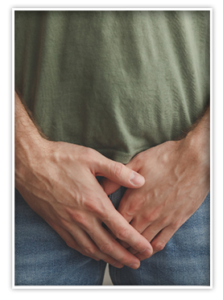Erectile Dysfunction
Among the people, impotence, erectile dysfunction (impotence-erectile dysfunction) is defined as the inability to achieve or maintain an erection sufficient for sexual intercourse.

Among the people, impotence, erectile dysfunction (impotence-erectile dysfunction) is defined as the inability to achieve or maintain an erection sufficient for sexual intercourse.

It is the most common sexual problem and is seen in approximately 50% of men over the age of 50. Considering all age groups, it can be seen in 30% of men. In a study conducted in Turkey, it was determined that 34% of men over the age of 40 had erectile dysfunction in varying degrees.
Erectile dysfunction is a condition that negatively affects the quality of life of the person and the partner. Lack of self-confidence, depression, family problems or even divorce can be a reason for a person. Although it was thought to be psychological in the past, it is actually a preliminary symptom of the underlying disease.
As a result of audio-visual or sexual stimulation by contact, the hormonal and nervous system is activated, and some chemical mediators (intermediate substances) secreted in the penis increase blood flow and erection is achieved.
Meanwhile, blood pressure increases in spongy bodies (corpus cavernosum) in the penis, these bodies fill with blood and full erection is achieved. In the meantime, the veins that carry the blood back to the system are closed and the erection is maintained. After orgasm-ejaculation (ejaculation), the blood accumulated in the penis returns to the blood stream and extinction occurs.
For a healthy erection, the psychology of the person's mood-health should also be appropriate.
For a healthy erection, the relevant region in the brain is activated by external stimuli (visual, auditory or sensual stimulation). Vasodilation substances are secreted in the penis by hormonal and neural transmission. Healthy blood vessels expand and 2 spongy bodies (corpus cavernosum) on the dorsal part of the penis fill with blood and swell and stretch.
In the meantime, the veins (veins) that allow the blood to return to the body are closed and a healthy full erection is achieved.
If there is a disruption in any or several stages of this mixed-complex system, erectile dysfunction (impotence) develops.
It is grouped under 2 main groups:

Many diseases can be listed among organic causes or risk factors:

When patients presenting with erectile dysfunction apply, the first and most important evaluation is to learn their medical history. Are there any disease risk factors? Does he receive treatment for these diseases? For example, does he receive treatment for diabetes and high cholesterol? What's his sugar level? If there is a history of cancer, how did he respond to treatment, did his disease progress?
Sometimes, patients apply to us with erectile dysfunction, and we determine the underlying cause as a result of examinations. For example, diabetes, hyperlipidemia or another hormonal disorder may be detected as a result of our evaluation.
While learning the medical history of our patients, their sexual desire, degree of erection, frequency of intercourse, sexual attitudes with their partners, spontaneous erections in the morning and at night, and their psychological state are also evaluated. In this evaluation, an attempt is made to distinguish between organic or psychogenic impotence.
A detailed physical examination is performed to examine the size of the testicles and the penis. Penis size, curvature (curvature), urinary hole (in terms of hypospadias), and peyronie's plaque are checked. In patients over 40 years of age, prostate examination should also be performed if necessary.
In order to detect the underlying disease, some blood tests (fasting blood sugar, testosterone, blood fats, thyroid hormones, liver enzymes, blood count, etc.) are requested from our patients. Stimulation test with drug injection into the penis (intracavernosal stimulation test) or penile doppler may also be requested in patients who need it.
Finally, our patients are asked to fill in an international inquiry form in order to evaluate their sexual performance. Thanks to this internationally accepted and used form, the severity of the problem is determined.
The treatment of erectile dysfunction should first be started with the treatment of the underlying disease, if any. For example, if he has diabetes or hypertension, it should be controlled. If the underlying cause is drug therapy, this therapy should be replaced with appropriate therapy.
The first treatment for erectile dysfunction is to change one's lifestyle. To this end:
In addition to lifestyle changes, there are some treatment methods we apply to our patients:
Medication: These treatments are the most common and the first form of treatment we use. With oral medications, penile blood vessels are further expanded. Although the active ingredient is different (sildenafil, tadalafil, vardenafil, avanafil) they act as an enzyme inhibitor called 5-phosphodiesterase and increase penile blood flow. There are different preparations used continuously or before intercourse. It is inconvenient to use them in people who use nitrates from heart medications. There may be mild side effects such as headache-muscle pain, nasal congestion, tinnitus, especially in the first weeks. These treatments are successful in up to 80% of patients.
Penile injection therapy: It is the injection of vasodilating drugs into the penis, which is applied to patients who do not benefit from drug therapy. Papaverine or Alprostadil is administered to the patient under the supervision of a physician and administered by the physician. Trimix, a mixture of 3 drugs (Papaverine, Phentolamine and Alprostadil), is the most effective mixture on the market. It is injected into the penis 15-20 minutes before the intercourse in the doses determined by the physician and sexual intercourse is ensured.
ESWT (low-intensity shock wave therapy-low-intensity schock-wave therapy): Low-intensity shock waves are sent to the penis to form new blood vessels. A total of 6-12 sessions can be applied at certain intervals. We use it in mild to moderate erectile dysfunction, which has no side effects and is recommended by the European Urology Guidelines.
It has no side effects, it is a painless procedure. No preparation is required during the procedure and patients return to their normal lives after the procedure. It provides 75% success in mild-moderate erectile dysfunction and 50% success in moderate-severe patients after 12-24 sessions. Patients usually start to see results after 1 month, and its effectiveness continues for up to 1 year.
PRP (Platelet Rich Plasma): The blood taken from the patient is taken into a special tube and after some processes, the proteins (plasma) that stimulate cell regeneration are separated. This separated plasma is injected into the penis with a very fine needle. Thus, regeneration of blood vessels and new vessel formation in the penis are stimulated. It is usually applied in combination with ESWT therapy. It can be applied once a week or every 2 weeks.
After the procedure, patients can return to their social lives.
Penile prosthesis (penile prosthesis): It is the device that provides artificial hardening applied to patients who do not benefit from other treatments. They are surgically placed inside the bodies (corpus cavernosum) that provide erection in the penis. There are different brands and models of prostheses. Basically, prostheses are divided into 2: inflatable and bendable ones.
As the malleable ones are understood in the name, prostheses made of flexible and harder material are placed inside the corpuscles in the penis. It can be felt from the outside. It is easy to use and low cost.
Other types of inflatables are also 2 types. In 3-piece inflatable prostheses, a reservoir (reservoir) is placed in the inguinal region, unlike the 2-piece ones. This reservoir contains water. 3-piece prostheses are the most physiological and an exact imitation of real penile erection. These prostheses are slightly more difficult to use and costly.
In the penis, 2 balloon-shaped prostheses are placed inside the corpuscles, a water reservoir in the groin area (this part does not exist in 2 pieces) and a pump in the ovary. The person presses the pump in the ovary before intercourse and the water moves towards the balloons from the reservoir placed in the groin and hardening is achieved. At the end of the intercourse, the penis is deflated by pressing the button on the pump. During extinction, the water in the penile bodies returns to the reservoir in the groin area.
Hi, Its a wounderful post.Thanks for your nice post. Do you know? But there are other causes and risk factors for hyperthyroidism that fall outside of the realm of autoimmune diseases. Your age and gender can also play a role.